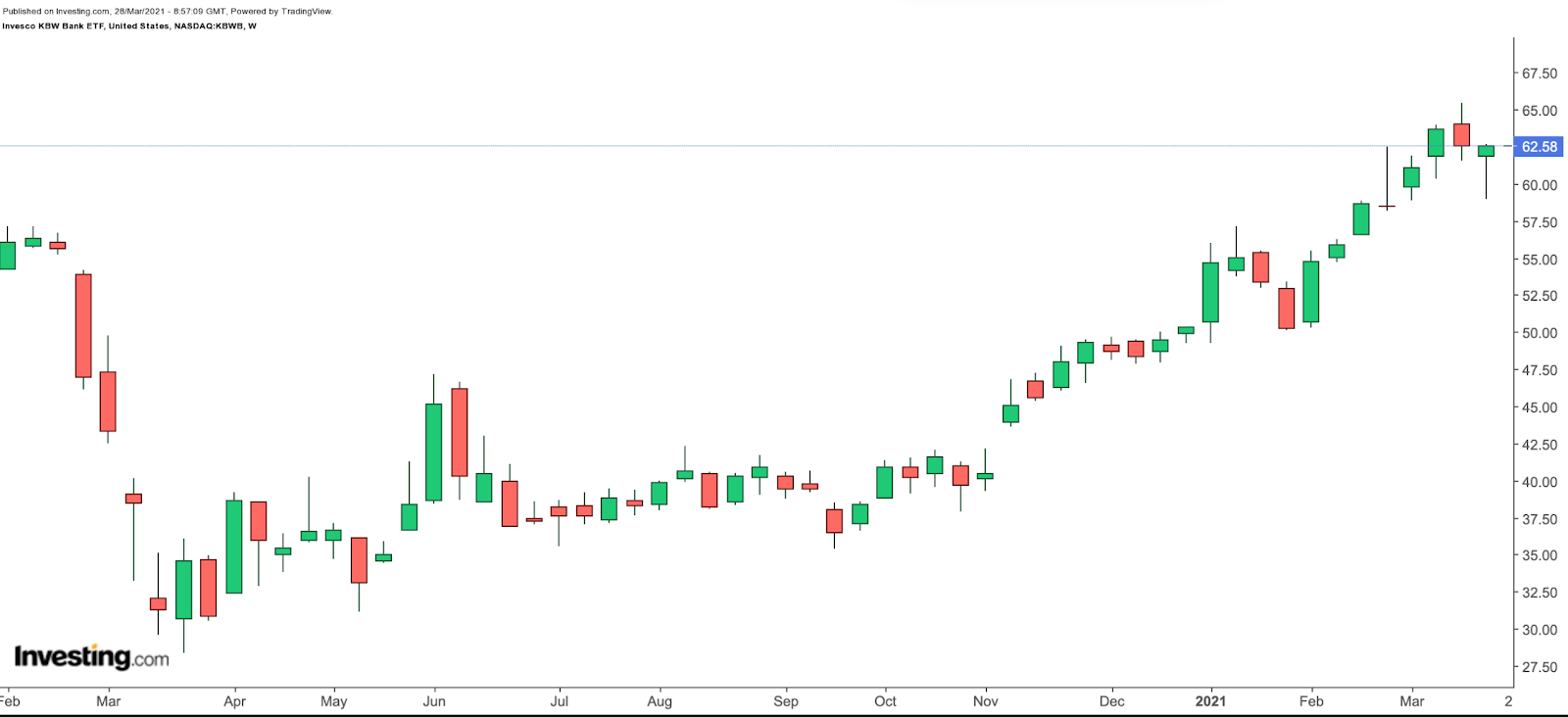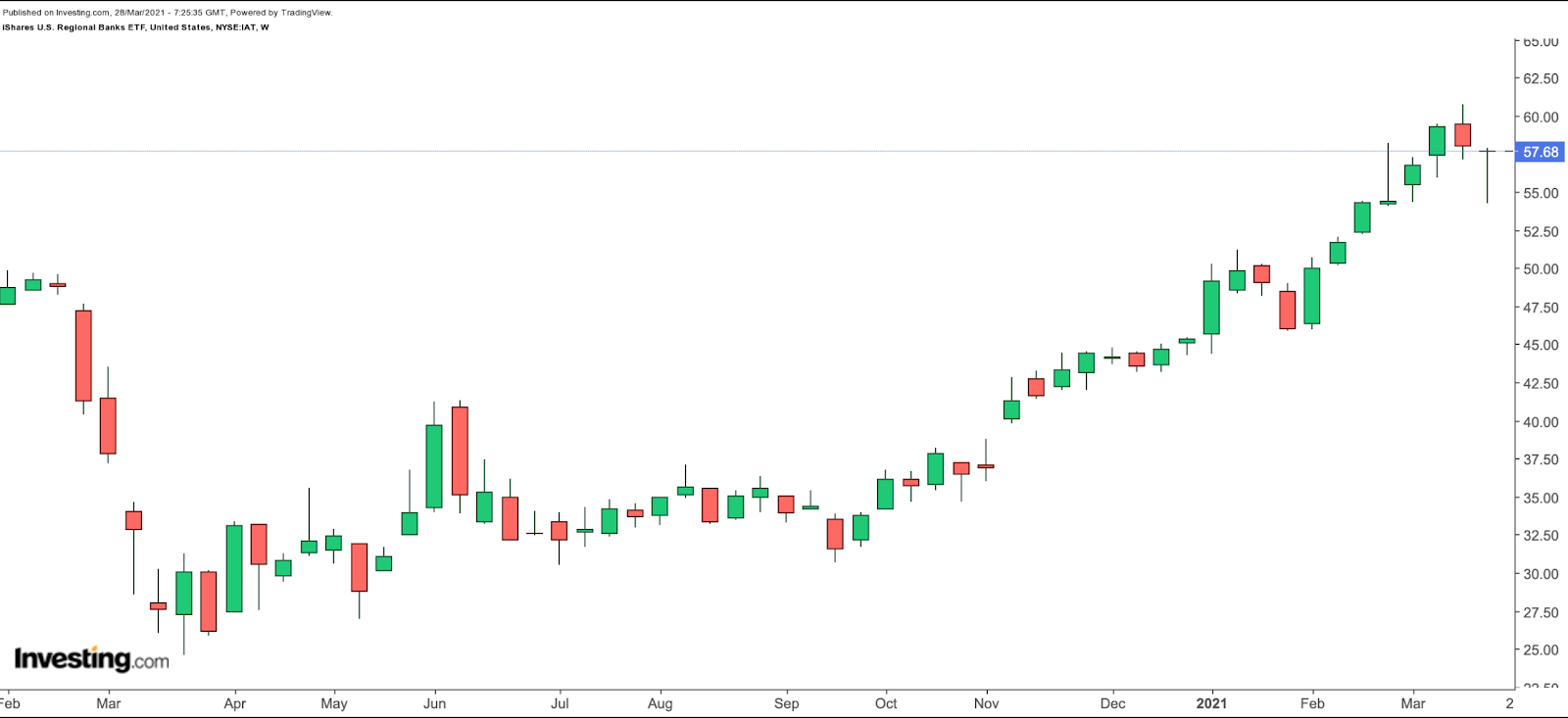The rise in Treasury yields has made the markets jittery. In recent weeks, the US 10-year Treasury yield hit its highest level since late March 2020 and moved above 1.7%. Now it is hovering at 1.67%. Analysts expect the potential economic bounce-back along with tighter monetary policy to easily mean further upside for yields.
Meanwhile, banking shares have been rising along with Treasury yields, a headwind for many industries, but not necessarily for financial institutions. Higher rates typically mean higher net interest income and profit margins for banks. For instance, the Dow Jones Banks Index has returned over 25% year-to-date (YTD). Interest rates affect banks' earnings and hence share prices.
In previous articles, we covered what the increase in yields and inflation might mean, as well as several exchange-traded funds (ETFs) focusing on the financial sector (here, here and here).
Today, we continue to introduce two more banking ETFs that might be of interest to readers who expect risks to financial institutions to dissipate further in the coming months.
1. Invesco KBW Bank ETF
- Current Price: $62.58
- 52-Week Range: $30.50 - $65.49
- Dividend Yield: 1.99%
- Expense Ratio: 0.35% per year
The Invesco KBW Bank ETF (NASDAQ:KBWB) invests in US banks, including large national US money centers (i.e., large-capitalization banks in cities like New York and with national and global operations), regional banks and thrift institutions. 
KBWB, which tracks the Settle KBW Nasdaq Bank Index, holds 26 stocks. Since its inception in November 2011, assets under management have reached $2.2 billion.
The top ten names comprise about 57% of the fund. Bank of America (NYSE:BAC), Citigroup (NYSE:C), Wells Fargo (NYSE:WFC) and JPMorgan Chase (NYSE:JPM) are currently the leading stocks in KBWB. These large banks have diversified revenue streams, such as investment banking, asset management and trading, and thus are not just reliant on interest rate moves.
Since the start of 2021, the fund is up over 24%, and hit an all-time high on Mar. 18. Forward P/E and P/B ratios are 13.22 and 0.79. Put another way, despite the recent gains, the fund is not expensive from a valuation standpoint.
Last week, the Federal Reserve Board announced that as of the end of June, most US banks will be able to increase dividend payouts and buy back shares. The current restrictions were put into place in April 2020. However, limitations will continue for financial institutions that do not perform well in stress tests. Many of the constituents of KBWB are likely to meet the requirements of the Fed. Therefore, the fund could easily see further capital inflows.
However, we should remind readers that the earnings season will soon start with reports by banks. Therefore, the sector is likely to be volatile in April. Potential investors could regard declines as an opportunity to enter the fund.
2. iShares US Regional Banks ETF
- Current Price: $57.68
- 52-Week Range: $25.85 - $60.79
- Dividend Yield: 2.11%
- Expense Ratio: 0.42% per year
The iShares US Regional Banks ETF (NYSE:IAT) gives access to the regional bank sub-sector of the US equity market. These institutions are typically small and mid-size banks stateside.
IAT, which has 54 holdings, tracks the returns of the Dow Jones US Select Regional Banks Index. Both the index and the fund are reconstituted quarterly. The fund began trading in May 2006, and assets stand at $645.7 million.
As the leading ten stocks make up over 60% of the fund, it is a top-heavy ETF. Among the premier names are Trust Financial (NYSE:TFC), PNC Financial Services (NYSE:PNC), US Bancorp (NYSE:USB) and First Republic Bank (NYSE:FRC).
Year-to-date (YTD), the ETF returned over 27%. Trailing P/E and P/B ratios stand at 19.13 and 1.41, respectively. Given the recent run-up in price, we'd wait for a potential decline to buy into the fund. A fall toward the $55 level or even below would offer a better margin of safety.
Although IAT currently sits at a record high level, we believe the firms in the fund could continue to create shareholder value in future quarters, too. However, those investors expecting yields to decline and even re-test previous lows would need to be cautious in terms of investing in banking shares or funds at these levels.
